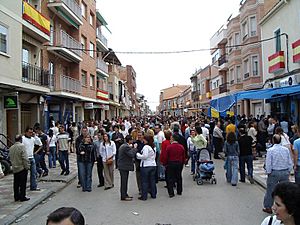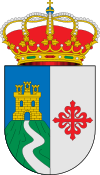Calzada de Calatrava facts for kids
Quick facts for kids
Calzada de Calatrava
|
|||
|---|---|---|---|

Calle Real
|
|||
|
|||
| Country | Spain | ||
| Autonomous Community | Castilla–La Mancha | ||
| Province | Ciudad Real | ||
| Government | |||
| • Type | Ayuntamiento | ||
| • Body | Ayuntamiento de Calzada de Calatrava | ||
| Area | |||
| • Total | 411 km2 (159 sq mi) | ||
| Elevation
(AMSL)
|
646 m (2,119 ft) | ||
| Population
(2018)
|
|||
| • Total | 3,802 | ||
| • Density | 9.251/km2 (23.96/sq mi) | ||
| Demonym(s) | calzadeño, -ña | ||
| Time zone | UTC+1 (CET) | ||
| • Summer (DST) | UTC+2 (CEST) | ||
| Postal code |
13370
|
||
| Area code(s) | +34 (Spain) + (Ciudad Real) | ||
Calzada de Calatrava is a town in Spain. It is located in the province of Ciudad Real. This province is part of the Castilla–La Mancha region. The town is also part of the Campo de Calatrava area. About 4,500 people live there.
Contents
History of Calzada de Calatrava
Calzada de Calatrava started growing in the early 1200s. It was built near two important castles. These were the Sacred Convent of Calatrava la Nueva and the Castle of Salvatierra. The town helped support the knights and soldiers of the Order of Calatrava. This order was a powerful group of knights. They controlled this area for many years.
Ancient Times in Calzada
People have lived in this area for a very long time. We know this from old tools found here. These tools date back to the Lower Paleolithic period. This means people were here thousands of years ago.
Archaeologists have found stone tools at a place called El Alamo. They also found tools near Casa Calle. These discoveries show that people lived here from the Stone Age to the Bronze Age. Other sites like Güedos and El Prado also have ancient remains.
The Carlist War Event
A sad event happened in Calzada de Calatrava in 1838. This was during the First Carlist War. A group of about 5,000 soldiers came to the town. Many people from Calzada and nearby towns hid in the Santa Maria Nuestra Señora del Valle Church. They were trying to be safe.
The soldiers attacked the church. They set it on fire. The church roof fell, and many people died. This included 110 men, 25 women, and 29 children. The church area later became a park. You can still see some old stone blocks from the church there.
Becoming a City
On January 22, 1895, Calzada de Calatrava became a city. The queen at that time, Maria Cristina of Habsburg, gave it this special title. She did this for her son, King Alfonso XIII.
Modern Events
In 2011, a special event happened in the town. The Pope's cross and an important religious symbol visited Calzada. This was part of the World Youth Day celebrations.
Famous People from Calzada
Many notable people come from Calzada de Calatrava.
- Fray Jorge de la Calzada
- Abul Nuaym Ridwan
- Pedro Almodóvar, a famous movie director.
- Paco Racionero, an actor.
- Jose Vicente Romero Camacho, a composer.
- Mateo Casado Real, a poet.
- Manu Ríos, an actor.
See also
 In Spanish: Calzada de Calatrava para niños
In Spanish: Calzada de Calatrava para niños




